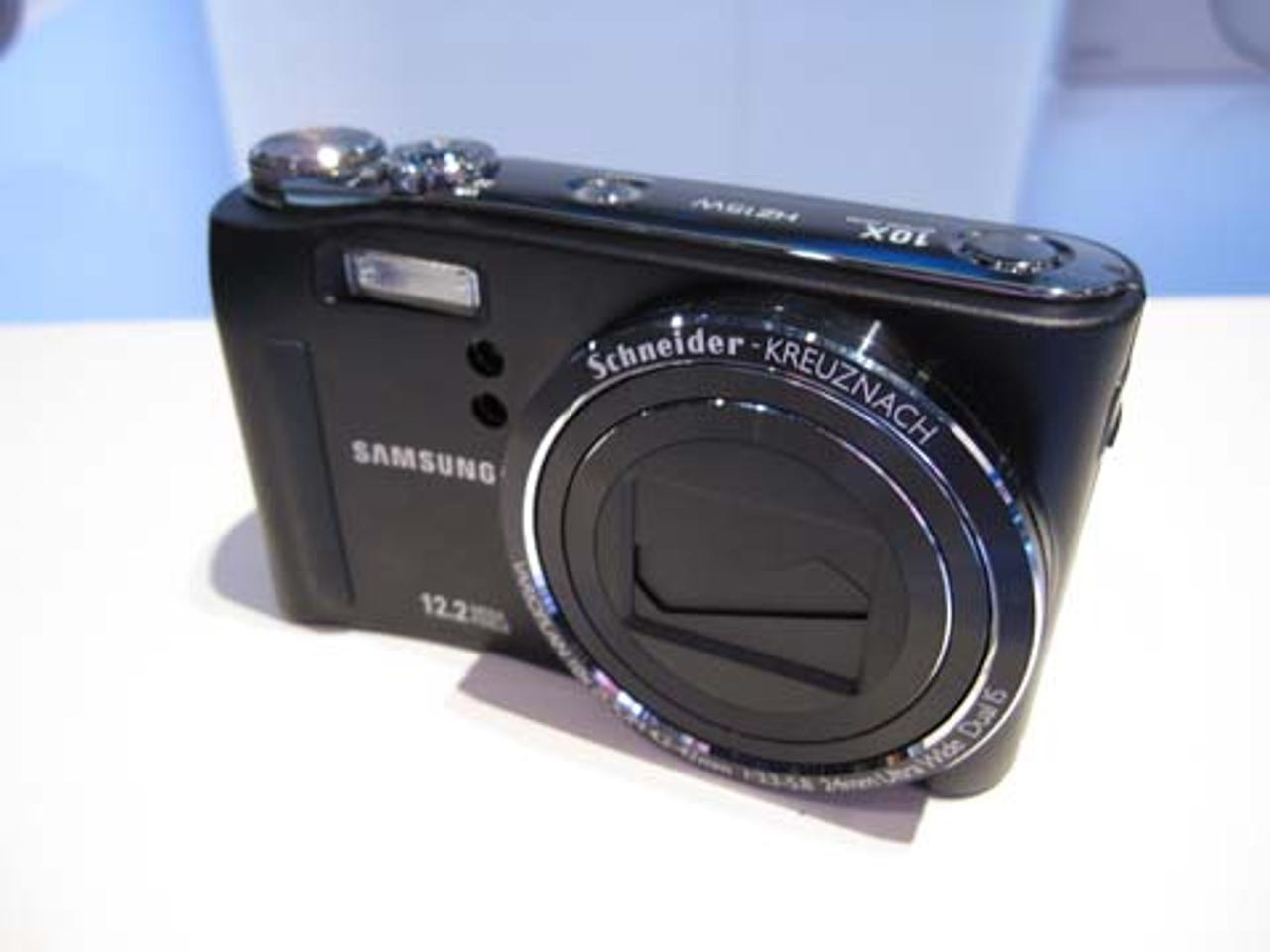PMA 2009: New camera and camcorder technology

The Sweep Panorama feature in the Cyber-shot DSC-HX1 can capture up to 224-degree panorama shots or 154-degree vertical shots in one press-and-sweep motion. The image processor automatically stitches them together into images with a maximum resolution of 7,152x1,080 (ultra wide horizontal).
Samsung announced it is also working on a Micro Four Thirds camera, the NX series. Details are sketchy--the company hasn’t even announced who will provide the lenses, though Samsung has a relationship with Pentax--but the camera body looks relatively compact. Panasonic currently sells a Micro Four Thirds camera, the Lumix DMC-G1, and Olympus has one in the works.
Late last year Panasonic introduced the industry's first Micro Four Thirds camera, the Lumix DMC-G1. At PMA, Panasonic showed a new Micro Four Thirds model, the Lumix DMC-GH1, which looks identical to the G1, but is also capable of recording full HD video. It also has a new kit lens.
The PowerShot SX200 IS squeezes a 12X image-stabilized optical zoom lens into a point-and-shoot style camera. Kodak, Nikon and Samsung were among the other companies showing relatively compact point-and-shoots with large zoom lenses.
Casio has pushed the novel high-speed photography features from its EX-F1 and EX-FH20 down into smaller and lighter point-and-shoot and ultracompacts. The EX-FC100 and EX-FS10 can both capture up to 30 frames per second in burst mode and can shoot video at 1000 frames per second.
There are 10 different Art Effects in the Olympus E-620 ranging from Pop Art to Grainy Black & White. Think of these as Photoshop filters you can apply in-camera.
The PowerShot SX1 IS is Canon's first PowerShot with a CMOS image sensor similar to the ones found in digital SLRs. It is also capable of shooting images in RAW format. All other PowerShot cameras--including the G10 for enthusiasts, which also shoots in RAW--use CCD image sensors.
Fujifilm's FinePix F200 is based on a new EXR Super CCD and EXR image processor that balances between high resolution in uniformly-lit scenes, wide dynamic range in high-contrast scenes, and high sensitivity and low noise in low-light situations.
Sony made a lot of noise with the panorama feature in its Cyber-shot DSC-HX1, but GE also introduced the feature in its A series cameras.
Kodak announced one new camera at the show, the EasyShare Z915, a compact 10-megapixel model with a 10X image-stabilized optical zoom lens. It will be available in April for less than $200.
The Nikon Coolpix P90 puts the mega in mega-zoom with its 24X wide-angle 26mm-624mm (35mm equivalent) telephoto lens. The 12.1-megapixel camera uses Nikon's image sensor shift VR image stabilization.
The Nikon Coolpix S630 is a compact 12-megapixel point-and-shoot camera with a 7X zoom lens. It has Nikon's image sensor shift VR image stabilization along with other features for capturing sharper images.
The Olympus E-620 has a Multiple Exposure feature which can combine two images in-camera to create interesting effects. Higher-end Olympus digital SLRs can combine more than two images.
Olympus's heavily-hyped Micro Four Thirds camera remains a concept, but is now has a release date of sometime this summer. Panasonic already sells a Micro Four Thirds camera, the Lumix DMC-G1, and Samsung plans to release one as well.
Several Panasonic Lumix digital cameras have an Auto-Focus Tracking feature that locks onto a face or object and follows it as it moves around in the frame. In this demo, the AF bracket is chasing the red train around an oval track.
Many cameras have Face Detection, which automatically identifies faces in scenes and attempts to optimize focus and image settings accordingly. Panasonic ups the ante with Face Recognition. With this feature, you can "register" up to five faces in the cameras firmware, and the camera should automatically recognize those faces in scenes and give them priority. The tags remain with the images, and bundled software can recognize up to 10 faces.
This cross-section of the Panasonic Lumix DMC-G1 shows why a Micro Four Thirds camera, with no mirror or prism, is more compact and lightweight than a digital SLR.

Panasonic has talked a lot about wide-angle lenses, but Samsung says they did it first. One of Samsung's latest models, the HZ15W, has a 10X wide-angle lens with a focal length of 24-240mm (35mm equivalent).
Samsung's TL320 is a gadget-lover's dream combining a 3-inch OLED display with analog gauges (on top) displaying memory and battery life remaining.
The Sony Cyber-shot DSC-HX1 is capable of shooting up to 10 frames per second at full resolution. You can then select the best image, and if you choose, the camera will delete the others from the card. The DSC-HX1 also uses this technology to produce better-quality images when shooting in Anti-Blur and Twilight modes.
The DSC-H1X is Sony's first Cyber-shot camera with a CMOS image sensor, which Sony calls Exmor. It also uses the same high-quality G lens found in Sony's alpha digital SLRs.
Sony's new high-definition Handycams use a new back-illuminated CMOS sensor--Sony calls it Exmor R--that relocates the support circuitry so that it isn’t blocking some of the light from reaching the sensor. The result is better detail with less noise in dark scenes.
Sony's new hard drive-based Handycams, including the high-end HDR-XR520V with a 240GB drive, have a built-in GPS receiver. The camcorder displays your current location on the LCD and "geotags" video and 12.1MP stills. It also automatically adjusts the camcorder's clock to the correct time zone.